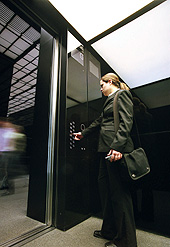 |
| Jjjjjjjjjjjjjjjjjjjjjjjjjjjjjjjjjjjjjjjjjjjjjjjjjjjjjjjjjjjjjjjjjjjjjjjjjjjjjjjjjjjjjjjjjjjjjjjjjjjjjjjjjjjjjjjjjjjjjjjjjjjjjjjjjjjjjjjjjjjjjjjjjjjjjjjjjjjjjjjjjjjjjjjjjjjjjjjjjjjjjjjjjj |
“My elevator phobia is so severe that I don’t want to try to overcome it,” said Neufeld, a freelance court transcriber who works out of her home in Kew Gardens, Queens. “Frankly, I think people who use elevators are crazy.”
There are no statistics on the number of people who are elevator phobic, but it is a problem that afflicts working people across the nation.
Mary Hartman’s job as a financial counsellor for a hospital system in Fort Wayne, Indiana, requires her to attend monthly meetings on the fourth floor of the company’s corporate headquarters. That was never a problem until last year, when the stairwells were locked as a security precaution. Now she always arrives early enough to find someone with a key.
And if no one is around? “I can take the elevator if I have to,” she said. “I do breathing exercises,” she added. “And I stand there like a scared rabbit.”
Some people benefit from spousal support or the kindness of strangers. Michal Regev, a registered psychologist in Vancouver, British Columbia, once treated an executive whose wife rode up to the 31st floor with him every day and met him at the end of the day for the trip home.
In extreme cases, though, “the very thought of entering an elevator can trigger a full-blown panic attack”, Regev said. In those situations, the only strategy may be outright avoidance. Regev recalled a software engineer who passed up an attractive job offer in a high-rise building for a much lower-paying job in a three-storey hospital.
Neufeld, 55, says that while her aversion has limited her professionally — “I might have had a career as a court reporter, but that would mean travelling to courts and law offices on high floors,” — she is fine with that.
I am not crazy about elevators myself, although I live in a 12th floor apartment in Manhattan and my work often requires my presence in the upper reaches of midtown skyscrapers.
For the most part, I manage fine, provided the car moves swiftly and smoothly with no hiccups and the doors open promptly. Anything less than a perfect ride, though, and suddenly I am the next Ming Kuang Chen, the restaurant deliveryman who spent more than three days in a stalled Bronx high-rise elevator in 2005.
It isn’t the terror of falling that spooks me so much as the idea of being confined.
For others, elevator phobia originates in the chilling certainty that the frayed shoelace on which the car is suspended will snap. In reality, on the rare occasions when a cable does break, the car does not plunge to the bottom. Elevators move up and down on as many as 10 cables, any one of which can support a fully loaded car.
But couldn’t all the cables come undone at the same time? That has happened only once, in 1945, when a B-25 bomber crashed into the 79th floor of the Empire State Building. “All the cables were severed and the car went into free fall with two women inside,” said Robert Caporale, editor of Elevator World magazine. “Even so, both survived.”
People do get hurt and even die in elevators, the same as they do riding in any other type of conveyance. According to the United States Consumer Product Safety Commission, there were about 8,800 elevator-related injuries, 70 of them fatal, from 2001 to 2006. Considering that Americans take about 120 billion rides a year, “that’s an excellent safety record”, Caporale said.
But for the elevator-averse, statistics yield little comfort. While a few can trace their fears to a specific situation, more often “there is no underlying trauma, just as people develop driving phobias without ever having been in a car accident,” said Fredric Neuman, director of the Anxiety and Phobia Treatment Center at White Plains Hospital Center.
The good news is that elevator phobias appear to be treatable. Many practitioners take a behavioural modification approach. The therapist accompanies the patient to the elevator in the patient’s workplace. Initially, they just look at the car from the outside, but they work up to entering and closing the door a few times. “When the patient is ready, we’ll try a few test runs to lower floors,” Neuman said.
These days, he said: “I tell patients that if they do get stuck between floors for an extended period, I can describe almost minute by minute how they’ll react — how much time they’ll spend pressing all the floor buttons, calling for help, trying to get the emergency phone to work and finally relaxing. No one dies and no one goes crazy.”
That is nice to know. And I will try to keep Neuman’s words in mind the next time I’m caught in a malfunctioning elevator. At the moment, though, I don’t feel reassured.











